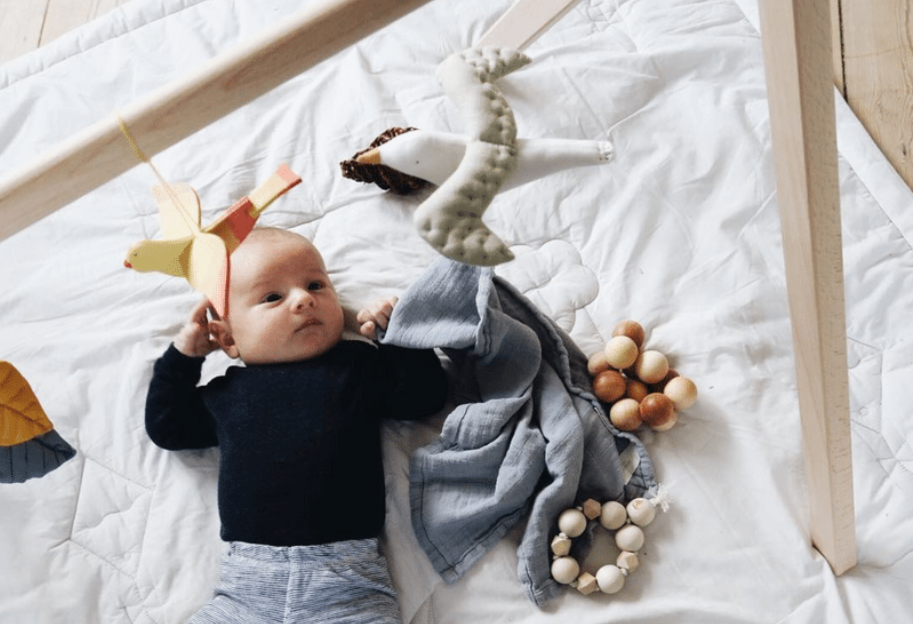Is it the endless screw?

Many parents find that very young children sleep best in motion or noise. It makes sense when you consider where the baby comes from. There is more noise and movement in the womb than you might think. Therefore, your baby does not intuitively know what it means to fall asleep peacefully. It has to be learned and midwife and sleep counselor Karen Kildahl knows something about that.
As a sleep counselor at the Baby Institute, Karen has guided thousands of families who struggle with sleep in one way or another. She also teaches on the course Sleep in Babysteps, which deals with all possible sleep problems in the family with young children, including movement.
From sleep in motion to sleep in rest
It is of course important to say that movement is not a bad habit in itself - not even when it comes to sleep. After all, this is how we all started out in the womb - with sleep in motion. Completely natural.
But after the birth, many families find that moving sleep becomes impractical.
At first, the long walks with the pram may be pleasant enough, but if your baby can only sleep when you are actively involved, it becomes both exhausting and unsustainable in the long run.
According to sleep counselor Karen Kildahl, you can help your child make the journey from awake to asleep in many ways and it doesn't have to involve movement:
“It requires patience, but it's not rocket science. We know it from everything else we have to learn as children. Nor do we start with Harry Potter when we have to learn to read. We start with sounds, letters and pixie books - and then we slowly upgrade from there.”
In my talk with Karen, I sense that slowly is an important password. And then it's not just about settling down - without being rocked to sleep. It is also largely about helping the baby continue to sleep.
Fall asleep and stay asleep
You know it for sure from yourself. You just scan the room before going to sleep. Especially if you are sleeping in a new place. Maybe you do it unconsciously, but your brain registers what is happening around you before you fall asleep. It is a kind of security measure. The brain ensures that you can safely lower the parade and let go of consciousness.
When we are safe, we sleep best. At least as long as a sleep cycle typically lasts (an hour and a half for adults). Each time you complete a sleep cycle, your consciousness wakes up a little. But if everything is ok, you just continue to sleep.
Karen says that the same thing happens to most people children's rooms:
"The child just takes a mental screenshot of the situation before sleep takes over. So when consciousness knocks after half an hour (children have a somewhat shorter sleep cycle than adults), everything should ideally be as on the mental screenshot. If something is different (eg if the movement has stopped), there is good reason to wake up completely. Because maybe it is not safe to sleep anymore?”
Therefore, it is attractive to look at how we teach our children to fall asleep - without movement. When it also helps the child to stay asleep for a longer period of time, it seems that both children and adults benefit from it.
But how do you do that? How do you teach your baby to fall asleep on his own - without movement?
How to help your child fall asleep himself
Karen explains that sleep in motion mainly contains four elements, each of which is addictive in its own way and therefore helps to confirm to the child that movement is necessary to fall asleep (and maintain sleep).
If you want to help your child from movement to rest, you can slowly reduce the addictive elements:
“The four addictive elements of movement are speed, direction, power and rhythm.
How fast do you set off with the pram? How fast can you jump on the pilates ball? Try to slow down the pace.
When we talk about direction, "up and down" is significantly more difficult for the nervous system to unlearn than "side to side". It's simply more addictive to bounce. And not a bad word about it. There's a reason why the swing cradle, which bounces up and down, is so popular in many homes. It can be a lifesaver for families who struggle with sleep. However, try to slowly phase out the "up and down" movement and replace it with "side to side".
How powerful are the movements you use? There is a big difference between whether the pram rolls on newly laid asphalt or old cobblestones. Try to step down with an intermediate object, e.g. a dirt road.
Finally, we have the rhythm. A tactful rhythm is soothing and addictive for the brain. This is why jazz can be stressful to listen to. Apologies to all jazz fans, but although there is plenty of rhythm in jazz, it is rarely very tactful and therefore it is a good example. Try to break up the rhythm of the movement a little without going completely jazz crazy. For example, start by pausing the rhythm at every fourth beat and slowly expand from there.”
Again that word there: slowly. Teaching a baby to fall asleep peacefully is a process that cannot be taken in one go. It would be like telling an adult that he suddenly has to sleep standing up. Boom. It's not going to work. Unless you're a lifeguard, perhaps.
But with small steps - or baby steps - even the biggest changes are possible.



Leave a comment
This site is protected by hCaptcha and the hCaptcha Privacy Policy and Terms of Service apply.